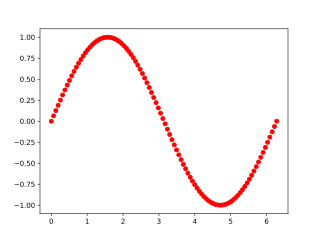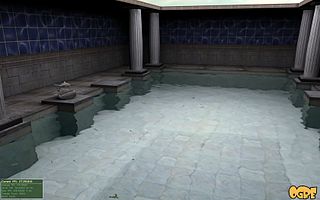The topic of this article may not meet Wikipedia's general notability guideline .(January 2018) |
The topic of this article may not meet Wikipedia's general notability guideline .(January 2018) |
For scientific plotting applications, Gist is a scientific graphics library written in C by David H. Munro of Lawrence Livermore National Laboratory. [1] [2] [3] It supports three graphics output devices: X Window, PostScript, and Computer Graphics Metafiles (CGM). The library is promoted as being small (written directly to Xlib), efficient, and full featured. Portability is restricted to systems running X Window (essentially, the Unix world).
There is a Python port of Gist called PyGist; [4] it is used as one of several optional graphics front ends of the scientific library SciPy. PyGist is also ported to Mac OS and Microsoft Windows. [5]

Python is a high-level, general-purpose programming language. Its design philosophy emphasizes code readability with the use of significant indentation.

NumPy is a library for the Python programming language, adding support for large, multi-dimensional arrays and matrices, along with a large collection of high-level mathematical functions to operate on these arrays. The predecessor of NumPy, Numeric, was originally created by Jim Hugunin with contributions from several other developers. In 2005, Travis Oliphant created NumPy by incorporating features of the competing Numarray into Numeric, with extensive modifications. NumPy is open-source software and has many contributors. NumPy is fiscally sponsored by NumFOCUS.

PyQt is a Python binding of the cross-platform GUI toolkit Qt, implemented as a Python plug-in. PyQt is free software developed by the British firm Riverbank Computing. It is available under similar terms to Qt versions older than 4.5; this means a variety of licenses including GNU General Public License (GPL) and commercial license, but not the GNU Lesser General Public License (LGPL). PyQt supports Microsoft Windows as well as various kinds of UNIX, including Linux and MacOS.

PyGTK is a set of Python wrappers for the GTK graphical user interface library. PyGTK is free software and licensed under the LGPL. It is analogous to PyQt/PySide and wxPython, the Python wrappers for Qt and wxWidgets, respectively. Its original author is GNOME developer James Henstridge. There are six people in the core development team, with various other people who have submitted patches and bug reports. PyGTK has been selected as the environment of choice for applications running on One Laptop Per Child systems.
Psyco is an unmaintained specializing just-in-time compiler for pre-2.7 Python originally developed by Armin Rigo and further maintained and developed by Christian Tismer. Development ceased in December, 2011.
CPython is the reference implementation of the Python programming language. Written in C and Python, CPython is the default and most widely used implementation of the Python language.
CherryPy is an object-oriented web application framework using the Python programming language. It is designed for rapid development of web applications by wrapping the HTTP protocol but stays at a low level and does not offer much more than what is defined in RFC 7231.
In the field of computer network administration, pcap is an application programming interface (API) for capturing network traffic. While the name is an abbreviation of packet capture, that is not the API's proper name. Unix-like systems implement pcap in the libpcap library; for Windows, there is a port of libpcap named WinPcap that is no longer supported or developed, and a port named Npcap for Windows 7 and later that is still supported.

PyPy is an implementation of the Python programming language. PyPy often runs faster than the standard implementation CPython because PyPy uses a just-in-time compiler. Most Python code runs well on PyPy except for code that depends on CPython extensions, which either does not work or incurs some overhead when run in PyPy.

Compiz is a compositing window manager for the X Window System, using 3D graphics hardware to create fast compositing desktop effects for window management. Effects, such as a minimization animation or a cube workspace, are implemented as loadable plugins. Because it conforms to the ICCCM conventions, Compiz can be used as a substitute for the default Mutter or Metacity, when using GNOME Panel, or KWin in KDE Plasma Workspaces. Internally Compiz uses the OpenGL library as the interface to the graphics hardware.

Python-Ogre is a Python binding for the OGRE 3D engine, designed to provide the functionality and performance of OGRE with the accessibility and ease of use of Python to facilitate the rapid development of 3D games and to make the OGRE engine more accessible to the beginner, who might otherwise be daunted by the technicalities of writing in the native C++. The performance of the engine is decreased in comparison to the original C++ demos, however the original OGRE engine provides such high performance that the performance of Python-Ogre is still more than acceptable for all but the most graphics-intensive games.

The FEniCS Project is a collection of free and open-source software components with the common goal to enable automated solution of differential equations. The components provide scientific computing tools for working with computational meshes, finite-element variational formulations of ordinary and partial differential equations, and numerical linear algebra.

Cython is a superset of the programming language Python, which allows developers to write Python code that yields performance comparable to that of C.
hOCR is an open standard of data representation for formatted text obtained from optical character recognition (OCR). The definition encodes text, style, layout information, recognition confidence metrics and other information using Extensible Markup Language (XML) in the form of Hypertext Markup Language (HTML) or XHTML.

Phatch is a raster graphics editor used to batch process digital graphics and photographs. Phatch can be used on the desktop as a GUI program or on the server as a console program.

PySide is a Python binding of the cross-platform GUI toolkit Qt developed by The Qt Company, as part of the Qt for Python project. It is one of the alternatives to the standard library package Tkinter. Like Qt, PySide is free software. PySide supports Linux/X11, macOS, and Microsoft Windows. The project can also be cross compiled to embedded systems like Raspberry Pi, and Android devices.
Tensor software is a class of mathematical software designed for manipulation and calculation with tensors.

Zim is a graphical text editor designed to maintain a collection of locally stored wiki-pages, a personal wiki. It works as a personal knowledge base and note-taking software application that operates on text files using markdown. Each wiki-page can contain things like text with simple formatting, links to other pages, attachments, and images. Additional plugins, such as an equation editor and spell-checker, are also available. The wiki-pages are stored in a folder structure in plain text files with wiki formatting. Zim can be used with the Getting Things Done method.